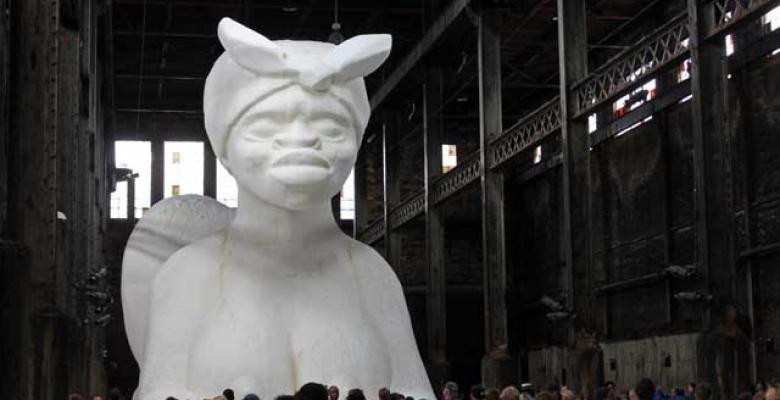Kara Walker's New World Sphinx:
Columbia School of the Arts professor Kara Walker has never been one to sugarcoat the truth—and she isn’t stopping now with her first large-scale public project: "A Subtlety, or the Marvelous Sugar Baby, an homage to the unpaid and overworked artisans who have refined our sweet tastes from the cane fields to the kitchens of the New World on the occasion of the demolition of the Domino Sugar Refining Plant."
Step into the cavernous space of the hulking Domino Sugar Factory on the Williamsburg, Brooklyn waterfront and you will be greeted by a retinue of forlorn, life-size figures of boys holding baskets, all made from molasses and brown sugar. Rising behind them out of the darkness, startlingly white and standing more than 35 feet high and 75 feet long, is the sphinx-like sugar baby, created out of refined white sugar over blocks of Styrofoam.
Walker has consistently used her art for pointed social commentary about slavery and the history of race relations in the United States since her student days at the Rhode Island School of Design, from which she earned her MFA in 1994. She received a MacArthur Award in 1997 at age 27, and has participated in numerous national and international exhibitions, including the full-scale traveling retrospective, "Kara Walker: My Complement, My Enemy, My Oppressor, My Love," which opened at the Walker Art Center in 2007 and traveled to ARC/Musée d'Art Moderne de la Ville de Paris, the Whitney Museum of American Art in New York and the Hammer Museum in Los Angeles.
Walker says that her work “is about trying to get a grasp on history … it’s kind of a trap … the meaty, unresolved, mucky blood lust of talking about race where I always feel like the conversation is inconclusive.”
For more information, visit http://creativetime.org/projects/karawalker/.
Kellie Jones, Social Protest and Race Relations at Brooklyn Museum:
"Witness: Art and Civil Rights in the Sixties" offers a focused look at painting, sculpture, graphics and photography from a decade defined by social protest and American race relations.
The exhibit, organized by Kellie Jones, associate professor in the Department of Art History and Archaeology and Teresa A. Carbone, Andrew W. Mellon Curator of American Art, Brooklyn Museum, was mounted in observance of the 50th anniversary of the Civil Rights Act of 1964. The exhibition considers how 66 of the decade’s artists—including African Americans and some of their white, Latino, Asian American, Native American and Caribbean contemporaries—used wide-ranging aesthetic approaches to address the struggle for racial justice. Featured are Romare Bearden, Jacob Lawrence, Faith Ringgold, Gordon Parks, Andy Warhol, Robert Indiana, Norman Rockwell and more.
The 1960s was a period of dramatic social and cultural upheaval, when artists aligned themselves with the massive campaign to end discrimination and bridged racial borders through creative work and acts of protest. Bringing activism to bear in gestural and geometric abstraction, assemblage, minimalism, pop imagery and photography, these artists produced powerful works informed by the experience of inequality, conflict and empowerment. In the process, they tested the political viability of their art, and originated subjects that spoke to resistance, self-definition and blackness.
“We mostly understand the Civil Rights Act and the ‘60s through photography, but not the visual arts, so it was important to go back and look at the period through these other art forms that had been in dialogue with the civil rights movement throughout the decade,” said Jones. “Arts and activism is not a topic of visual arts, per se—not something art historians typically look at or teach—but I do, and my students at Columbia are so familiar with a lot of these works because I teach the ‘60s and the artists of that time.”
For more information, visit http://www.brooklynmuseum.org/exhibitions/witness_civil_rights/.
